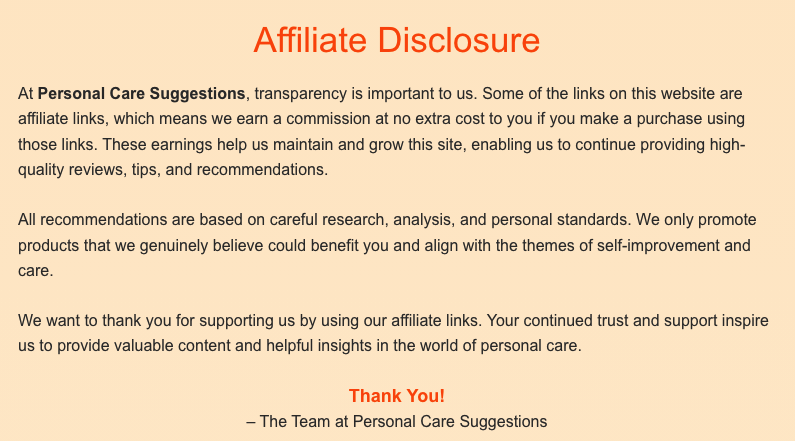Creating A Disclosure Statement For Affiliates

A well-written disclosure statement is critical for affiliate marketing. It not only fulfills legal obligations but also establishes trust with your audience. Clear and honest disclosures empower readers to make informed choices. Below, I outline the steps I follow to create effective disclosure statements for affiliate partnerships.
Step 1: Understand the Purpose of a Disclosure Statement
A disclosure statement explains your affiliate relationships and how they influence your content. It’s a transparency tool that reassures visitors about your honesty. When drafting one, I focus on:
- Complying with legal requirements
- Building trust with readers
- Choosing a clear and straightforward style
This foundation simplifies the process and ensures the message is both informative and credible. A clear statement not only fosters trust but also enhances your reputation by clearly outlining what users can expect.
Step 2: Familiarize Yourself with Affiliate Disclosure Guidelines
Affiliate disclosure guidelines are essential for protecting both publishers and readers. These rules ensure that your statements are transparent and not misleading. Each country may have specific requirements, so staying informed is key. Important considerations include:
- Labeling affiliate links clearly
- Writing in simple, easy-to-read language
- Describing affiliate relationships accurately
- Following regional and industry-specific laws
For more information on crafting compliant disclosures, visit the FTC Homepage. Staying compliant not only builds trust but helps maintain a positive online presence.
Step 3: Draft Your Disclosure Statement
The drafting stage is where you outline the key points of your disclosure. Keep it concise and easy to understand, avoiding overly technical terms. A typical affiliate disclosure might include:
- A brief note about affiliate links or paid promotions
- An explanation of potential earnings, such as commissions
- Details about affiliate agreements, if required
For example, “This page contains affiliate links, and I may earn a commission at no extra cost to you.” This straightforward approach ensures that readers are aware of the affiliate relationship, fostering trust and transparency.
An Example of a Disclosure Statement

Step 4: Use a Template and Follow Best Practices
Using a disclosure statement template can simplify the process and ensure you don’t miss vital details. A good template should:
- Cover all necessary information
- Provide a consistent structure
- Save time while maintaining accuracy
Templates are especially useful when managing multiple affiliate partnerships. Adjust them as needed to suit specific agreements or scenarios, ensuring clarity and compliance.
Step 5: Tailor Statements for Specific Agreements
Every affiliate partnership is unique, so it’s important to customize your disclosure to reflect specific terms. Key details might include:
- Commission percentages or types, if permitted
- Assurance that commissions don’t affect pricing
- Mentions of additional partnerships, if relevant
Regular updates keep your statements accurate and aligned with current affiliate agreements. This demonstrates your commitment to transparency and compliance.
Step 6: Review and Maintain Compliance
Creating a disclosure statement isn’t a one-time task. Regular reviews ensure your statement remains accurate and compliant with evolving guidelines. My review process includes:
- Verifying compliance with current rules
- Simplifying language for clarity
- Updating changes in affiliate relationships or agreements
Staying current with legal and industry standards helps maintain trust and prevent potential issues. Regular audits of your disclosure ensure it remains relevant and effective.
Step 7: Address Common Questions
- What if the disclosure is too long? Simplify it by removing unnecessary words while keeping key points intact.
- How do I keep the tone honest? Use straightforward language, as if explaining to a friend.
- What if my affiliate relationships change? Update the statement promptly and include the last review date.
- How do I ensure legal compliance? Stay informed about affiliate disclosure guidelines and consult experts if needed.
Final Thoughts
Creating a clear disclosure statement is essential for ethical and effective affiliate marketing. It builds trust, boosts credibility, and keeps you compliant with legal standards. Through careful drafting, the use of templates, and regular reviews, you can maintain a reliable and transparent affiliate program. For additional resources on this topic, explore Apex Affiliate Disclosure.
By following these steps, you can create a disclosure statement that not only meets legal requirements but also strengthens your connection with your audience. This process is more than a formality—it’s an opportunity to show your commitment to honesty and transparency in affiliate marketing.

Hello, I’m Michael, the founder of apexaffiliate.com. A few years ago, I was searching for a way to make money online and break free from the daily grind of the 9-5 lifestyle. Like many, I encountered countless “Done for you” and “Get Rich Quick” schemes, but eventually, I got lucky and discovered my path to success.
That turning point was Wealthy Affiliate, a platform I now consider home and the cornerstone of my online achievements. I want to share this journey with you and provide helpful insights into the basics of affiliate marketing, with the goal of making your path smoother than mine.
Join me, and let’s navigate this journey together—I’ll be here every step of the way to guide you.










